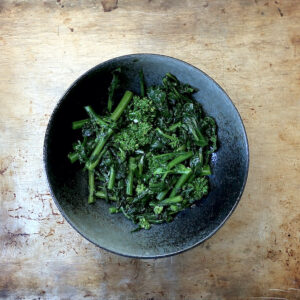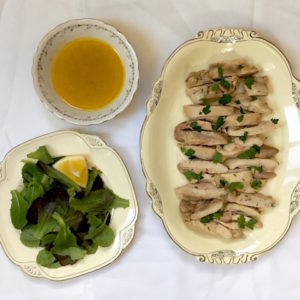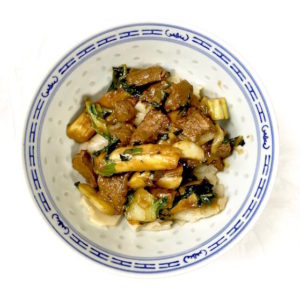New Year’s Greens
To wildly twist a Marilyn Manson phrase, it’s not that I don’t like the vegetables, it’s that they don’t like me.
How to put this delicately?
Ehlers Danlos attacks the entire digestive system, causing heartburn and G.I. issues not discussed in polite company. Suffice to say, the vegetables I do eat must be cooked, if not to death, then quite thoroughly. Happily, greens take beautifully to this treatment, growing ever more silky and digestible as they cook.
This dish is adapted from Paula Wolfert’s wonderful Mediterranean Grains And Greens, specifically, the “Dragged Greens” recipe. Note the cooking method, which asks you to parboil large, tough greens before sauteeing them in a slick of olive oil. According to Wolfert, this preliminary boiling tenderizes, releases flavor, and preserves color. She notes that cooking large leaves in a skillet without first blanching them leads to dry, shriveled, even burnt greens. Having prepared greens both ways myself, I concur. A preliminary boiling bath does wonders for greens, enhancing not only their digestibility but their texture.
A word on chard and collard stems: many cooks treat leafy ribs and stems as separate vegetables. The French turn chard stems into gratins and even have a sweet cake recipe calling for chard ribs, arranged in a pretty spoke pattern. Americans tend to dump their stems in the trash or compost. While always happy to eat a gratin, I also enjoy leafy green ribs and stems, and see no reason to omit them when preparing greens. Instead, I trim away just the frazzled bits.
A dish of greens at the New Year is traditional in many cultures. In the American South, the green color, hearkening to money, is hoped to attract more, while green is generally thought fortuitous, drawing good fortune in the coming months. That said, I make this often, varying the greens with what’s available at the market or in my fridge. You can use a single green like chard or kale, or follow Wolfert’s suggestion and use a mix of greens–kale, Swiss chard, turnip greens, escarole, even bagged salad mix.
New Year’s Greens
Adapted from Paula Wolfert’s Mediterranean Grains And Greens
Cooking time: approximately 1 hour
Serves: 2-3, easily multiplied
1 large bunch greens: Swiss chard, turnip greens, kale, or a mixture of greens
1 medium waxy potato, scrubbed
1 teaspoon garlic, peeled and minced
1 teaspoon rosemary, minced
1 ounce pancetta or bacon, diced (optional, see instructions)
salt
black pepper
pinch hot red pepper flakes
2 tablespoon olive oil

First clean your greens. Many cookbooks recommend rinsing greens in running water, an effective method but not viable in drought country.
To wash greens in drought country:
Fill your largest bowl with cold water. Immerse the greens, allowing them to sit from 10 minutes to all day. This also refreshes wilted leaves.
When ready to cook, make sure leaves are grit-free; if not, fill the bowl with fresh water and swish each leaf individually, rubbing off dirt with your fingers. Remove leaves to a cutting board.

Fill a large pot with salted water. Bring to a boil.
The potato can be treated a couple ways. To avoid waterlogged spuds, Wolfert cooks hers whole, unpeeled. As the potato is cooked further, I don’t find waterlogging a problem. Quartering the potato allows it to cook more quickly. The choice is yours. Either way, drop the potato into the boiling water.
Roughly chop the greens. Add to the pot and stir, keeping the greens submerged.
Allow potato and greens to cook about 10 minutes. Potato should be soft and greens completely softened. If the potato is whole, it will take longer to cook than the greens.
Ladle the greens to a colander, pressing down on them to extract as much moisture as possible. Allow to cool.

When potato is cooked, remove from water to cutting board. When cool enough to handle, remove the peel–it should slip off easily–and eat it as cook’s treat. It will be lightly salted and delicious. Break potatoes into small pieces. Or, if you’re lazy, wait until the next step to break them up in the pot.
Once greens are cool enough to handle, squeeze any remaining water out with your hands. Chop greens well, taking care to slice stems into manageable pieces.
The next step calls for sauteeing the potato and greens in olive oil. You can do this in a clean skillet, but why dirty another pot? Pour a generous 2 tablespoons olive oil into your dirty pot and turn heat to low.
Add potato, pancetta, rosemary, garlic, salt, pepper, and hot pepper. Take care not to burn the rosemary and garlic. If you haven’t broken up the potato, do it now with a wooden spoon or other suitable implement. You want bite-sized pieces, not mash.
Add greens and turn up the heat a little, stirring to blend everything. Cook about 8-10 minutes. You aren’t looking to brown the potatoes, just meld the ingredients. Add a little more oil if contents look dry or begin sticking.
Taste for seasoning, adding more salt or hot pepper if wished. Try not to eat it all yourself at the stove.
Notes:
One bunch of greens will feed only two or three people; if feeding more, scale up, adding a little more olive oil.
In her recipe, Wolfert suggests using a variety of leafy greens. This is great place to toss in stray leaves, leftover parsley, the last half-bag of designer salad mix.
This recipe isn’t about the potato or the pork. Both are there as complements to the greens.
Take care with rosemary. Too much rapidly overtakes a dish.
Happy New Year!





